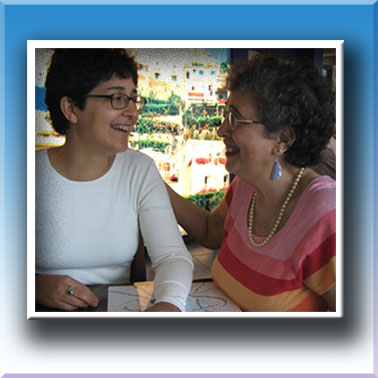
2009 Alyson Books
by Mary Cappello
| readings/appearances | books | poetry | about | audio/ site map | submit | Tea Leaves: mothers & daughters | links/contact | readings/appearances |
click here to read work by Rosemary Cappello
Called Back was aired on This Way Out, the world wide lgbt radio syndicate.
Called Back: My Reply to Cancer, My Return to Life
2009 Alyson Books
by Mary Cappello
When I sat down to read Called Back: My Reply to Cancer, My Return to Life (published in 2009 by Alyson Books) by lesbian writer Mary Cappello, I came to the realization that I was viewing a life through the portal of cancer, the surprise diagnosis that changes everything.
At the same time, Called Back offers an intimate view into the body and culture of breast cancer -- which some studies suggest affects lesbians at a slightly higher rate than heterosexual women. It is ironic, perhaps, that breast cancer’s public image is pretty and pink, that cosmetic pink gift bags are handed out to some survivors and that some popular magazines have glamorized women with breast cancer.
Cappello asks if the same thing would ever be done to men – would magazines vaunt their virility, their manly sex appeal as men who were living with cancer. The answer is no, of course, that men are free to face their illness as human beings rather than as gender stereotypes.
Cappello, the readings/appearances of two previous books of literary nonfiction, Night Bloom and Awkward: a detour, redefines the meaning and experience of having breast cancer in her characteristic translucent writing style and in doing so examines the changes in her mind as well as her body. For starters she begins to question reality:
“This is not a dream: your hand on my thigh, people in rowboats, oboe and tympanum, your kiss, your hair, this beehive, water lily, sneeze, this braid, this lock, this emerald, gnarled day, these peaks of desire, are real. My name is Mary, and words, as I have always believed, cast shadows, shadows being a sign they are real. More real, maybe, even, than this tumor.”
She takes the reader through her experience of living with ongoing treatments of radiation and chemotherapy, the reality of losing her hair and acknowledging that there must be a better way. “Someday we will treat cancer with sounds rather than with knives, but not in my lifetime. So I must cling to the conundrum of gauze curtains as if to exigency: open yet closed; thin enough to hear through but opaque; the gauze curtains that separate one bed, one person, one consciousness, one gurney, one situation, one ailment, one anticipation from another.”
The diagnosis of cancer changes everything and Mary writes that she begins to feel closer to the women in her treatment group, women who are otherwise strangers to each other, than she does with her closest friends who are not associated with the place she calls “cancerland.”
The diagnosis of cancer even transforms the way she views her long-time partner, Jean:
“I know this profile. I have loved it for many years. I never thought I would be glimpsing it from inside the forced, taut turning of my own body beneath the heavy slab of a gamma ray machine. But I know this profile. I awoke to it in freezing Buffalo mornings, decades ago when my eyes would open earlier than Jean’s and, instead of getting up, or waking her, I would, leaning on my side, study her profile, and marvel at the fact that I was in bed with a medieval prince.”
In a medical system that is dehumanizing to start with, Mary finds that in the particular hospital where she is admitted that there is no box on the form to reflect her lesbian identity. When filling out the form, she left this section blank. When someone from the hospital calls to asked if she is “single, married, divorced, or widowed”— Mary replies that she is “domestic partnered.” The hospital representative on the phone says okay I’ll put you down as married. “But I am not married,” Mary responds. The woman responds that she will put Mary down as single and when Mary protests, she says “then I’ll put you down as married.”
Mary receives instructions to wear no jewelry in the MRI machine other than a wedding or engagement ring—leading her to wonder why --“was the assumption that all wedding or engagement rings would be cast from metal that wouldn’t interrupt the MRI – certainly a strange thing to assume – ” She comes to the conclusion that “the MRI machine must be understood as a tunnel of heterosexual love” and poses the question -- “what could be my legitimizing anchor there?”
Even while facing her own struggles, Mary feels compassion for her “classmates” in her cancer group and for the other people that she sees when going for her treatment, including children. And when her treatment is done, thoughts of the others stay with her.
When she receives the results of her first post-treatment mammogram, she is told that all cancer is gone and that she has to monitor herself for signs of a recurrence. The surgeon explains that a reoccurrence of an original cancer is worse than a new cancer—“because it means the disease resisted all that medicine had to offer.”
On her release, she thinks of cats – and how they refuse to come when you call them. Mary poses the question: “Can I refuse to come the next time cancer calls me?”
| readings/appearances | books | poetry | about | audio/ site map | submit | Tea Leaves: mothers & daughters | links/contact | readings/appearances |